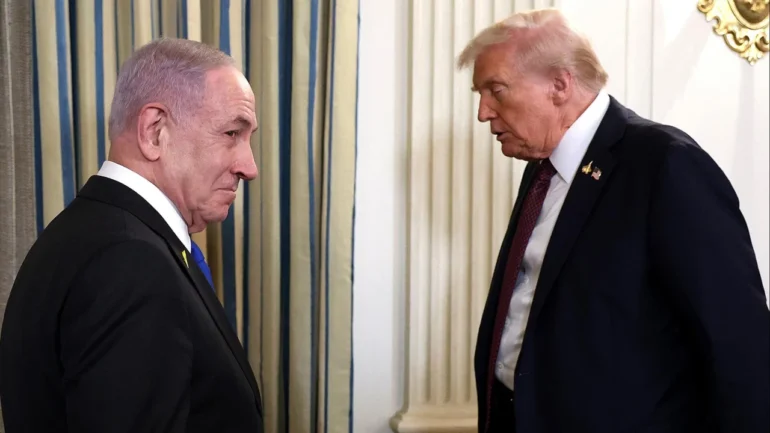On September 29, 2025, former U.S. President Donald Trump, alongside Israeli Prime Minister Benjamin Netanyahu, unveiled a 20-point peace plan aimed at ending the nearly two-year conflict in Gaza. The proposal has sparked cautious optimism among Middle Eastern and European leaders, but residents of Gaza and some analysts remain skeptical about its feasibility, particularly due to Hamas’s lack of involvement in the negotiations.
Key Elements of the Plan
The plan outlines several ambitious steps to halt the violence and rebuild Gaza:
-
Immediate Ceasefire and Hostage Exchange: The proposal calls for an immediate end to fighting, with Hamas releasing all hostages—living and deceased—within 72 hours. In return, Israel would release 250 life-sentence prisoners and 1,700 Gazans detained since October 7, 2023, including women and children.
-
Israeli Withdrawal: Israeli forces would withdraw in stages, contingent on Hamas’s disarmament and the establishment of a transitional government.
-
Hamas Disarmament: The plan demands that Hamas relinquish its weapons and governance role in Gaza, with amnesty offered to members who commit to peace.
-
Transitional Governance: A “Board of Peace,” chaired by Trump and including figures like former UK Prime Minister Tony Blair, would oversee a temporary, apolitical Palestinian committee to govern Gaza until the Palestinian Authority (PA) completes reforms.
-
Economic Development: A special economic zone and redevelopment plan would aim to rebuild Gaza’s infrastructure, with international aid and investment to create jobs and opportunities.
-
International Stabilization Force (ISF): A temporary force, supported by regional partners like Jordan and Egypt, would train Palestinian police and secure Gaza’s borders to prevent weapons smuggling.
The plan also emphasizes that Israel will not occupy or annex Gaza and leaves open the possibility of eventual Palestinian statehood, though Netanyahu later reiterated his opposition to a Palestinian state.
Global Reactions
Leaders from Saudi Arabia, Jordan, the UAE, Qatar, Egypt, Turkey, Indonesia, and Pakistan welcomed the plan, expressing readiness to work with the U.S. to implement it. European leaders, including UK Prime Minister Keir Starmer, French President Emmanuel Macron, and Italian Prime Minister Giorgia Meloni, urged Hamas to accept the proposal, calling it a chance to end the suffering in Gaza. Former U.S. officials, such as Brett McGurk and Dan Shapiro, praised the plan as credible, stressing that international pressure must now focus on Hamas.
Skepticism in Gaza
Despite global support, many in Gaza view the plan with suspicion. Ibrahim Joudeh, a resident of southern Gaza, called it “unrealistic,” arguing that its conditions—particularly Hamas’s disarmament and exclusion from governance—are ones the group is unlikely to accept. Abu Mazen Nassar echoed this sentiment, questioning the lack of guarantees to end the war. Mohammed al-Beltaji, a 47-year-old from Gaza City, described the negotiations as a “game,” with ordinary Gazans bearing the cost.
However, some residents remain hopeful. Anas Sorour, a 31-year-old street vendor, expressed optimism, saying, “No war lasts forever. This time, I am very optimistic, and God willing, it will be a moment of joy that makes us forget our pain.”
Challenges and Criticisms
The plan’s success hinges on Hamas’s cooperation, which is uncertain. A senior Hamas official indicated openness to studying the proposal but insisted that any agreement must ensure a full Israeli withdrawal and safeguard Palestinian interests, including retaining their weapons as long as the “occupation” continues. The absence of Hamas in the plan’s drafting raises doubts about its viability.
The inclusion of Tony Blair on the “Board of Peace” has also drawn criticism. Mustafa Barghouti of the Palestinian National Initiative noted Blair’s negative reputation due to his role in the Iraq War, likening his involvement to a return of British colonialism.
In Israel, opinions are mixed. In Tel Aviv, where protests have demanded an end to the war and the return of hostages, some like Inbar Hayman are cautiously hopeful but wary of disappointment. Gal Goren, who lost both parents in the October 7, 2023, Hamas attack, welcomed Trump’s acknowledgment of their plight.
Context of the Conflict
The Gaza conflict escalated after a Hamas-led attack on southern Israel on October 7, 2023, which killed about 1,200 people and took 251 hostages. Israel’s military response has resulted in at least 66,055 deaths in Gaza, according to the Hamas-run health ministry, and caused widespread destruction. Recent Israeli strikes, including one that unintentionally killed a Qatari serviceman, have strained relations with allies.
Looking Ahead
Trump’s plan is a bold attempt to break the cycle of violence, but its success depends on Hamas’s response and the ability to navigate deep-seated mistrust. While global leaders see it as a step toward peace, the voices of Gazans like Mohammed al-Beltaji highlight a grim reality: “Israel agrees, then Hamas refuses—or the other way around. It’s all a game, and we, the people, are the ones paying the price.”
For now, the world watches to see if this ambitious proposal can bridge the divide or if it will join the list of failed ceasefire attempts in Gaza’s tragic conflict.
